Nanomaterial-Based Sensors for Exhaled Breath Analysis: A Review
Abstract
:1. Introduction
2. Origin of Biomarkers for Exhaled Breath Analysis
3. Various Detection Techniques for Exhaled Breath VOCs
4. NM-Based Sensors—Potential Candidates for Disease Diagnosis
4.1. Diabetes Mellitus
4.2. Lung Cancer
4.3. Breast Cancer
4.4. Kidney Diseases
4.5. Halitosis
4.6. COVID-19
5. Summary and Conclusions
6. Future Prospects
Author Contributions
Funding
Institutional Review Board Statement
Informed Consent Statement
Data Availability Statement
Acknowledgments
Conflicts of Interest
References
- Pleil, J.D.; A Stiegel, M.; Sobus, J.R.; Liu, Q.; Madden, M.C. Observing the human exposome as reflected in breath biomarkers: Heat map data interpretation for environmental and intelligence research. J. Breath Res. 2011, 5, 037104. [Google Scholar] [CrossRef] [PubMed]
- Bouza, M.; Gonzalez-Soto, J.; Pereiro, R.; De Vicente, J.C.; Sanz-Medel, A. Exhaled Breath and Oral Cavity VOCs as Potential Biomarkers in Oral Cancer Patients. J. Breath Res. 2017, 11, 016015. [Google Scholar] [CrossRef] [PubMed]
- Phillips, M. Breath Tests in Medicine. Sci. Am. 1992, 267, 74–79. [Google Scholar] [CrossRef]
- Campanella, A.; De Summa, S.; Tommasi, S. Exhaled breath condensate biomarkers for lung cancer. J. Breath Res. 2019, 13, 044002. [Google Scholar] [CrossRef]
- Kim, K.-H.; Jahan, S.A.; Kabir, E. A review of breath analysis for diagnosis of human health. TrAC Trends Anal. Chem. 2012, 33, 1–8. [Google Scholar] [CrossRef]
- Biagini, D.; Lomonaco, T.; Ghimenti, S.; Bellagambi, F.G.; Onor, M.; Scali, M.C.; Barletta, V.; Marzilli, M.; Salvo, P.; Trivella, M.G.; et al. Determination of volatile organic compounds in exhaled breath of heart failure patients by needle trap micro-extraction coupled with gas chromatography-tandem mass spectrometry. J. Breath Res. 2017, 11, 047110. [Google Scholar] [CrossRef]
- Miekisch, W.; Herbig, J.; Schubert, J. Data interpretation in breath biomarker research: Pitfalls and directions. J. Breath Res. 2012, 6, 036007. [Google Scholar] [CrossRef]
- Pleil, J.D.; Wallace, M.A.G.; Stiegel, M.A.; Funk, W.E. Human biomarker interpretation: The importance of intra-class correlation coefficients (ICC) and their calculations based on mixed models, ANOVA, and variance estimates. J. Toxicol. Environ. Heal. Part B 2018, 21, 161–180. [Google Scholar] [CrossRef] [Green Version]
- Konvalina, G.; Haick, H. Sensors for Breath Testing: From Nanomaterials to Comprehensive Disease Detection. Accounts Chem. Res. 2013, 47, 66–76. [Google Scholar] [CrossRef]
- Cheng, W.-H.; Lee, W.-J. Technology development in breath microanalysis for clinical diagnosis. J. Lab. Clin. Med. 1999, 133, 218–228. [Google Scholar] [CrossRef]
- Beauchamp, J. Inhaled today, not gone tomorrow: Pharmacokinetics and environmental exposure of volatiles in exhaled breath. J. Breath Res. 2011, 5, 037103. [Google Scholar] [CrossRef] [PubMed]
- Kim, I.-D. How can nanotechnology be applied to sensors for breath analysis? Nanomedicine 2017, 12, 2695–2697. [Google Scholar] [CrossRef] [PubMed] [Green Version]
- Zhang, C.-L.; Yu, S.-H. Nanoparticles meet electrospinning: Recent advances and future prospects. Chem. Soc. Rev. 2014, 43, 4423–4448. [Google Scholar] [CrossRef] [PubMed]
- Braun, P.X.; Gmachl, C.F.; Dweik, R.A. Bridging the Collaborative Gap: Realizing the Clinical Potential of Breath Analysis for Disease Diagnosis and Monitoring–Tutorial. IEEE Sensors J. 2012, 12, 3258–3270. [Google Scholar] [CrossRef]
- Espinal, L.; Poster, D.L.; Wong-Ng, W.; Allen, A.J.; Green, M.L. Measurement, standards, and data needs for CO2capture materials: A critical review. Environ. Sci. Technol. 2013, 47, 11960–11975. [Google Scholar] [CrossRef]
- Huang, J.; Li, Y.; Sood, S.; Gouma, P. Breath Biomarker Detection by Chemical Sensors. In Semiconductor-Based Sensors; World Scientific: Singapore, 2016; pp. 355–393. [Google Scholar] [CrossRef]
- Vishinkin, R.; Haick, H. Nanoscale Sensor Technologies for Disease Detection via Volatolomics. Small 2015, 11, 6142–6164. [Google Scholar] [CrossRef]
- Novak, B.J.; Blake, D.R.; Meinardi, S.; Rowland, F.S.; Pontello, A.; Cooper, D.M.; Galassetti, P.R. Exhaled methyl nitrate as a noninvasive marker of hyperglycemia in type 1 diabetes. Proc. Natl. Acad. Sci. USA 2007, 104, 15613–15618. [Google Scholar] [CrossRef] [Green Version]
- Galassetti, P.R.; Novak, B.; Nemet, D.; Rose-Gottron, C.; Cooper, D.M.; Meinardi, S.; Newcomb, R.; Zaldivar, F.; Blake, D.R. Breath Ethanol and Acetone as Indicators of Serum Glucose Levels: An Initial Report. Diabetes Technol. Ther. 2005, 7, 115–123. [Google Scholar] [CrossRef] [Green Version]
- Hakim, M.; Broza, Y.Y.; Barash, O.; Peled, N.; Phillips, M.; Amann, A.; Haick, H. Volatile Organic Compounds of Lung Cancer and Possible Biochemical Pathways. Chem. Rev. 2012, 112, 5949–5966. [Google Scholar] [CrossRef]
- Zhang, Y.; Guo, L.; Qiu, Z.; Lv, Y.; Chen, G.; Li, E. Early Diagnosis of Breast Cancer from Exhaled Breath by Gas Chromatography-Mass Spectrometry (GC/MS) Analysis: A Prospective Cohort Study. J. Clin. Lab. Anal. 2020, 34, 1–10. [Google Scholar] [CrossRef]
- Phillips, M.; Cataneo, R.N.; Saunders, C.; Hope, P.; Schmitt, P.; Wai, J. Volatile biomarkers in the breath of women with breast cancer. J. Breath Res. 2010, 4, 026003. [Google Scholar] [CrossRef] [PubMed]
- Choi, K.-I.; Kim, H.-J.; Kang, Y.C.; Lee, J.-H. Ultraselective and ultrasensitive detection of H2S in highly humid atmosphere using cuo-loaded SNO2 hollow spheres for real-time diagnosis of halitosis. Sens. Actuators B Chem. 2014, 194, 371–376. [Google Scholar] [CrossRef]
- Španěl, P.; Smith, D. What is the real utility of breath ammonia concentration measurements in medicine and physiology? J. Breath Res. 2017, 12, 027102. [Google Scholar] [CrossRef] [PubMed]
- Obermeier, J.; Trefz, P.; Happ, J.; Schubert, J.K.; Staude, H.; Fischer, D.-C. Exhaled volatile substances mirror clinical con-ditions in pediatric chronic kidney disease. PLoS ONE. 2017, 12, e0178745. [Google Scholar] [CrossRef] [PubMed] [Green Version]
- Lü, Q.; Zhang, Q.; Kang, S.; Bai, H.; Wang, C. [Determination of 10 volatile organic compounds in toys by headspace gas chromatography-mass spectrometry]. Chin. J. Chromatogr. 2010, 28, 800–804. [Google Scholar] [CrossRef]
- Feng, D.; Wang, J.; Ji, X.-J.; Min, W.-X.; Yan, W.-J. Analysis of Volatile Organic Compounds by HS-GC-IMS in Powdered Yak Milk Processed under Different Sterilization Conditions. J. Food Qual. 2021, 2021, 5536645. [Google Scholar] [CrossRef]
- Vu, D.C.; Ho, T.L.; Vo, P.H.; Carlo, G.; McElroy, J.A.; Davis, A.N.; Nagel, S.C.; Lin, C.-H. Determination of volatile organic compounds in child care centers by thermal desorption gas chromatography-mass spectrometry. Anal. Methods 2018, 10, 730–742. [Google Scholar] [CrossRef]
- Vu, D.C.; Ho, T.L.; Vo, P.; Bayati, M.; Davis, A.N.; Gulseven, Z.; Carlo, G.; Palermo, F.; McElroy, J.A.; Nagel, S.C.; et al. Assessment of indoor volatile organic compounds in Head Start child care facilities. Atmospheric Environ. 2019, 215, 116900. [Google Scholar] [CrossRef]
- Curran, K.; Underhill, M.; Gibson, L.T.; Strlic, M. The development of a SPME-GC/MS method for the analysis of VOC emissions from historic plastic and rubber materials. Microchem. J. 2016, 124, 909–918. [Google Scholar] [CrossRef]
- Bai, J.; Liu, S.; Xie, F.; Liu, H.; Xia, Q. [Analysis of volatile and semi-volatile compounds in tobacco using off-line combination of liquid chromatography and capillary gas chromatography-mass spectrometry]. Chin. J. Chromatogr. 2010, 28, 608–614. [Google Scholar] [CrossRef]
- Woollam, M.; Teli, M.; Angarita-Rivera, P.; Liu, S.; Siegel, A.; Yokota, H.; Agarwal, M. Detection of Volatile Organic Compounds (VOCs) in Urine via Gas Chromatography-Mass Spectrometry QTOF to Differentiate Between Localized and Metastatic Models of Breast Cancer. Sci. Rep. 2019, 9, 2526. [Google Scholar] [CrossRef] [PubMed] [Green Version]
- Lourenço, C.; Bergin, S.; Hodgkinson, J.; Francis, D.; Staines, S.E.; Saffell, J.R. Instrumentation for quantitative analysis of volatile compounds emission at elevated temperatures. part 1: Design and implementation. Sci. Rep. 2020, 10, 8700. [Google Scholar] [CrossRef] [PubMed]
- Westhoff, M.; Litterst, P.; Freitag, L.; Urfer, W.; Bader, S.; Baumbach, J.-I. Ion mobility spectrometry for the detection of volatile organic compounds in exhaled breath of patients with lung cancer: Results of a pilot study. Thorax 2009, 64, 744–748. [Google Scholar] [CrossRef] [Green Version]
- Bessa, V.; Darwiche, K.; Teschler, H.; Sommerwerck, U.; Rabis, T.; Baumbach, J.I.; Freitag, L. Detection of volatile organic compounds (VOCs) in exhaled breath of patients with chronic obstructive pulmonary disease (COPD) by ion mobility spectrometry. Int. J. Ion Mobil. Spectrom. 2011, 14, 7–13. [Google Scholar] [CrossRef]
- Güntner, A.T.; Abegg, S.; Königstein, K.; Gerber, P.A.; Schmidt-Trucksäss, A.; Pratsinis, S.E. Breath Sensors for Health Monitoring. ACS Sens. 2019, 4, 268–280. [Google Scholar] [CrossRef]
- Mirzaei, A.; Leonardi, S.G.; Neri, G. Detection of hazardous volatile organic compounds (vocs) by metal oxide nanostruc-tures-based gas sensors: A Review. Ceram. Int. 2016, 42, 15119–15141. [Google Scholar] [CrossRef]
- Khatoon, Z.; Fouad, H.; Seo, H.-K.; Alothman, O.Y.; Ansari, Z.A.; Ansari, S.G. Ethyl acetate chemical sensor as lung cancer bi-omarker detection based on doped nano-sno2 synthesized by sol-gel process. IEEE Sens. J. 2020, 20, 12504–12511. [Google Scholar] [CrossRef]
- Wang, J.; Han, S.; Ke, D.; Wang, R. Semiconductor Quantum Dots Surface Modification for Potential Cancer Diagnostic and Therapeutic Applications. J. Nanomater. 2012, 2012, 129041. [Google Scholar] [CrossRef]
- Velumani, M.; Meher, S.R.; Alex, Z.C. Impedometric humidity sensing characteristics of SnO2 thin films and SnO2–ZnO composite thin films grown by magnetron sputtering. J. Mater. Sci. Mater. Electron. 2017, 29, 3999–4010. [Google Scholar] [CrossRef]
- Gao, F.; Wang, M.; Zhang, X.; Zhang, J.; Xue, Y.; Wan, H.; Wang, P. Simultaneous detection of hydrogen and methane in breath for the diagnosis of small intestinal bacterial overgrowth by fast gas chromatography. Anal. Methods 2018, 10, 4329–4338. [Google Scholar] [CrossRef]
- Jung, Y.J.; Seo, H.S.; Kim, J.H.; Song, K.Y.; Park, C.H.; Lee, H.H. Advanced Diagnostic Technology of Volatile Organic Compounds Real Time analysis Analysis From Exhaled Breath of Gastric Cancer Patients Using Proton-Transfer-Reaction Time-of-Flight Mass Spectrometry. Front. Oncol. 2021, 11, 560591. [Google Scholar] [CrossRef] [PubMed]
- Ruzsanyi, V.; Mochalski, P.; Schmid, A.; Wiesenhofer, H.; Klieber, M.; Hinterhuber, H. Ion mobility spectrometry for de-tection of Skin Volatiles. J. Chromatogr. B 2012, 911, 84–92. [Google Scholar] [CrossRef] [PubMed] [Green Version]
- Rodrigues, J.; Amin, A.; Raghushaker, C.R.; Chandra, S.; Joshi, M.B.; Prasad, K.; Nayak, S.G.; Ray, S.; Mahato, K.K. Exploring photoacoustic spectroscopy-based machine learning together with metabolomics to assess breast tumor progression in a xen-ograft model ex vivo. Lab. Investig. 2021, 101, 952–965. [Google Scholar] [CrossRef] [PubMed]
- Tan, X.; Zhang, H.; Li, J.; Wan, H.; Guo, Q.; Zhu, H.; Liu, H.; Yi, F. Non-dispersive infrared multi-gas sensing via nanoantenna integrated narrowband detectors. Nat. Commun. 2020, 11, 5245. [Google Scholar] [CrossRef] [PubMed]
- Acharyya, S.; Nag, S.; Kimbahune, S.; Ghose, A.; Pal, A.; Guha, P.K. Selective Discrimination of VOCs Applying Gas Sensing Kinetic Analysis over a Metal Oxide-Based Chemiresistive Gas Sensor. ACS Sensors 2021, 6, 2218–2224. [Google Scholar] [CrossRef] [PubMed]
- Mukherjee, A.; Rosenwaks, Y. Recent Advances in Silicon FET Devices for Gas and Volatile Organic Compound Sensing. Chemosensors 2021, 9, 260. [Google Scholar] [CrossRef]
- Achmann, S.; Hämmerle, M.; Moos, R. Amperometric enzyme-based gas sensor for formaldehyde: Impact of possible in-terferences. Sensors 2008, 8, 1351–1365. [Google Scholar] [CrossRef] [Green Version]
- Prasanth, A.; Meher, S.; Alex, Z. Metal oxide thin films coated evanescent wave based fiber optic VOC sensor. Sensors Actuators A: Phys. 2022, 338, 113459. [Google Scholar] [CrossRef]
- Kaushik, S.; Tiwari, U.K.; Deep, A.; Sinha, R. Two-dimensional transition metal dichalcogenides assisted biofunctionalized optical fiber SPR biosensor for efficient and rapid detection of bovine serum albumin. Sci. Rep. 2019, 9, 6987. [Google Scholar] [CrossRef]
- Prasanth, A.; Meher, S.; Alex, Z. Experimental analysis of SnO2 coated LMR based fiber optic sensor for ethanol detection. Opt. Fiber Technol. 2021, 65, 102618. [Google Scholar] [CrossRef]
- Devkota, J.; Ohodnicki, P.R.; Greve, D.W. SAW Sensors for Chemical Vapors and Gases. Sensors 2017, 17, 801. [Google Scholar] [CrossRef] [PubMed] [Green Version]
- Hu, J.; Qu, H.; Pang, W.; Duan, X. In-line detection with microfluidic bulk acoustic wave resonator gas sensor for Gas Chro-matography. Sensors 2021, 21, 6800. [Google Scholar] [CrossRef] [PubMed]
- Azzouz, A.; Vikrant, K.; Kim, K.-H.; Ballesteros, E.; Rhadfi, T.; Malik, A.K. Advances in colorimetric and optical sensing for gaseous volatile organic compounds. TrAC Trends Anal. Chem. 2019, 118, 502–516. [Google Scholar] [CrossRef]
- Das, S.; Mahapatra, P.L.; Mondal, P.P.; Das, T.; Pal, M.; Saha, D. A highly sensitive cobalt chromite thick film based trace acetone sensor with fast response and recovery times for the detection of diabetes from exhaled breath. Mater. Chem. Phys. 2021, 262, 124291. [Google Scholar] [CrossRef]
- Daneshnazar, M.; Jaleh, B.; Eslamipanah, M.; Varma, R.S. Optical and Gas Sensing Properties of TiO2/RGO for Methanol, Ethanol and Acetone Vapors. Inorg. Chem. Commun. 2022, 145, 110014. [Google Scholar] [CrossRef]
- Singh, I.; Bedi, R.K. Ethanol, acetone and ammonia gas room temperature operated sensor. AIP Conf. Proc. 2013, 1536, 1175. [Google Scholar] [CrossRef]
- Hanh, N.H.; Van Duy, L.; Hung, C.M.; Xuan, C.T.; Van Duy, N.; Hoa, N.D. High-performance acetone gas sensor based on Pt–Zn2SnO4 hollow octahedra for diabetic diagnosis. J. Alloys Compd. 2021, 886, 161284. [Google Scholar] [CrossRef]
- Righettoni, M.; Tricoli, A.; Gass, S.; Schmid, A.; Amann, A.; Pratsinis, S.E. Breath acetone monitoring by portable Si:WO3 gas sensors. Anal. Chim. Acta 2012, 738, 69–75. [Google Scholar] [CrossRef] [Green Version]
- Brahma, S.; Yeh, Y.; Huang, J.; Liu, C. CU-doped zinc oxide fiber optic sensor for acetone detection at room temperature. Appl. Phys. A 2020, 126, 718. [Google Scholar]
- Kim, K.; Choi, P.G.; Itoh, T.; Masuda, Y. Catalyst-free Highly Sensitive SnO2 Nanosheet Gas Sensors for Parts per Billion-Level Detection of Acetone. ACS Appl. Mater. Interfaces 2020, 12, 51637–51644. [Google Scholar] [CrossRef]
- Imran, M.; Rashid, S.S.A.A.H.; Sabri, Y.; Motta, N.; Tesfamichael, T.; Sonar, P.; Shafiei, M. Template based sintering of WO3 nanoparticles into porous tungsten oxide nanofibers for acetone sensing applications. J. Mater. Chem. C 2019, 7, 2961–2970. [Google Scholar] [CrossRef] [Green Version]
- Xu, H.; Gao, J.; Li, M.; Zhao, Y.; Zhang, M.; Zhao, T.; Wang, L.; Jiang, W.; Zhu, G.; Qian, X.; et al. Mesoporous WO3 Nanofibers With Crystalline Framework for High-Performance Acetone Sensing. Front. Chem. 2019, 7, 266. [Google Scholar] [CrossRef] [PubMed]
- Yan, Y.; Wang, Q.; Li, W.; Zhao, Z.; Yuan, X.; Huang, Y.; Duan, Y. Discovery of potential biomarkers in exhaled breath for diagnosis of type 2 diabetes mellitus based on GC-MS with metabolomics. RSC Adv. 2014, 4, 25430–25439. [Google Scholar] [CrossRef]
- Koo, W.-T.; Choi, S.-J.; Jang, J.-S.; Kim, I.-D. Metal-Organic Framework Templated Synthesis of Ultrasmall Catalyst Loaded ZnO/ZnCo2O4 Hollow Spheres for Enhanced Gas Sensing Properties. Sci. Rep. 2017, 7, srep45074. [Google Scholar] [CrossRef] [Green Version]
- Zhang, Y.; Zhou, L.; Liu, Y.; Liu, D.; Liu, F.; Liu, F.; Yan, X.; Liang, X.; Gao, Y.; Lu, G. Gas sensor based on samarium oxide loaded mulberry-shaped tin oxide for highly selective and sub ppm-level acetone detection. J. Colloid Interface Sci. 2018, 531, 74–82. [Google Scholar] [CrossRef]
- Wang, L.; Teleki, A.; Pratsinis, S.E.; Gouma, P.I. Ferroelectric WO3 Nanoparticles for Acetone Selective Detection. Chem. Mater. 2008, 20, 4794–4796. [Google Scholar] [CrossRef]
- Kim, N.-H.; Choi, S.-J.; Kim, S.-J.; Cho, H.-J.; Jang, J.-S.; Koo, W.-T. Highly sensitive and selective acetone sensing perfor-mance of WO3 nanofibers functionalized by rh2o3 nanoparticles. Sens. Actuators B Chem. 2016, 224, 185–192. [Google Scholar] [CrossRef]
- Shen, J.-Y.; Zhang, L.; Ren, J.; Wang, J.-C.; Yao, H.-C.; Li, Z.-J. Highly enhanced acetone sensing performance of porous C-doped WO3 hollow spheres by carbon spheres as templates. Sens. Actuators B Chem. 2017, 239, 597–607. [Google Scholar] [CrossRef]
- Moon, H.G.; Jung, Y.; Jun, D.; Park, J.H.; Chang, Y.W.; Park, H.-H. Hollow Pt-functionalized SnO2 hemipill network for-mation using a bacterial skeleton for the noninvasive diagnosis of diabetes. ACS Sens. 2018, 3, 661–669. [Google Scholar] [CrossRef]
- Liu, W.; Zheng, Y.; Wang, Z.; Wang, Z.; Yang, J.; Chen, M. Ultrasensitive exhaled breath sensors based on anti-resonant hollow core fiber with in situ grown zno-bi2O3 nanosheets. Adv. Mater. Interfaces 2021, 8, 2001978. [Google Scholar] [CrossRef]
- Jiang, L.; Lv, S.; Tang, W.; Zhao, L.; Wang, C.; Wang, J.; Wang, T.; Guo, X.; Liu, F.; Wang, C.; et al. YSZ-based acetone sensor using a Cd2SnO4 sensing electrode for exhaled breath detection in medical diagnosis. Sens. Actuators B Chem. 2021, 345, 130321. [Google Scholar] [CrossRef]
- Kim, K.-H.; Kim, S.-J.; Cho, H.-J.; Kim, N.-H.; Jang, J.-S.; Choi, S.-J.; Kim, I.-D. WO3 nanofibers functionalized by protein-templated RuO2 nanoparticles as highly sensitive exhaled breath gas sensing layers. Sens. Actuators B Chem. 2017, 241, 1276–1282. [Google Scholar] [CrossRef]
- Staerz, A.; Kim, T.H.; Lee, J.H.; Weimar, U.; Barsan, N. Nanolevel Control of Gas Sensing Characteristics via P-n Heterojunction between Rh2O3 Clusters and WO3 Crystallites. J. Phys. Chem. C 2017, 121, 24701–24706. [Google Scholar] [CrossRef]
- Guo, J.; Zhang, D.; Li, T.; Zhang, J.; Yu, L. Green light-driven acetone gas sensor based on electrospinned CdS nanospheres/Co3O4 nanofibers hybrid for the detection of exhaled diabetes biomarker. J. Colloid Interface Sci. 2021, 606, 261–271. [Google Scholar] [CrossRef] [PubMed]
- Liu, L.; Li, S.; Zhuang, J.; Wang, L.; Zhang, J.; Li, H.; Liu, Z.; Han, Y.; Jiang, X.; Zhang, P. Improved selective acetone sensing properties of Co-doped ZnO nanofibers by electrospinning. Sens. Actuators B Chem. 2011, 155, 782–788. [Google Scholar] [CrossRef]
- Xiao, Y.; Lu, L.; Zhang, A.; Zhang, Y.; Sun, L.; Huo, L. Highly enhanced acetone sensing performances of porous and single crystalline zno nanosheets: High percentage of exposed (100) facets working together with surface modification with pd na-noparticles. ACS Appl. Mater. Interfaces 2012, 4, 3797–3804. [Google Scholar] [CrossRef]
- Wang, X.-J.; Wang, W.; Liu, Y.-L. Enhanced acetone sensing performance of Au nanoparticles functionalized flower-like ZnO. Sens. Actuators B Chem. 2012, 168, 39–45. [Google Scholar] [CrossRef]
- Liu, C.; Wang, B.; Liu, T.; Sun, P.; Gao, Y.; Liu, F. Facile synthesis and gas sensing properties of the flower-like NIO-decorated zno microstructures. Sens. Actuators B Chem. 2016, 235, 294–301. [Google Scholar] [CrossRef]
- Ma, X.; Zhou, X.; Gong, Y.; Han, N.; Liu, H.; Chen, Y. MOF-derived hierarchical zno/znfe2O4 hollow cubes for enhanced acetone gas-sensing performance. RSC Adv. 2017, 7, 34609–34617. [Google Scholar] [CrossRef] [Green Version]
- Liu, C.; Zhao, L.; Wang, B.; Sun, P.; Wang, Q.; Gao, Y.; Liang, X.; Zhang, T.; Lu, G. Acetone gas sensor based on NiO/ZnO hollow spheres: Fast response and recovery, and low (ppb) detection limit. J. Colloid Interface Sci. 2017, 495, 207–215. [Google Scholar] [CrossRef]
- Li, S.-M.; Zhang, L.-X.; Zhu, M.-Y.; Ji, G.-J.; Zhao, L.-X.; Yin, J.; Bie, L.-J. Acetone sensing of ZnO nanosheets synthesized using room-temperature precipitation. Sens. Actuators B Chem. 2017, 249, 611–623. [Google Scholar] [CrossRef]
- Wang, X.; Zhang, S.; Shao, M.; Huang, J.; Deng, X.; Hou, P.; Xu, X. Fabrication of ZnO/ZnFe2O4 hollow nanocages through metal organic frameworks route with enhanced gas sensing properties. Sens. Actuators B Chem. 2017, 251, 27–33. [Google Scholar] [CrossRef]
- Song, X.-Z.; Qiao, L.; Sun, K.-M.; Tan, Z.; Ma, W.; Kang, X.-L. Triple-shelled zno/znfe2o4 heterojunctional hollow micro-spheres derived from Prussian blue analogue as high-performance acetone sensors. Sens. Actuators B Chem. 2018, 256, 374–382. [Google Scholar] [CrossRef]
- Gong, F.; Peng, L.; Zhang, Y.; Cao, Y.; Jia, D.; Li, F. Selectively sensing H2S and acetone through tailoring the facets exposed on the surfaces of ZnO supercrystals. Mater. Lett. 2018, 218, 106–109. [Google Scholar] [CrossRef]
- Li, Y.; Chen, L.-L.; Lian, X.-X.; Li, J. Formation Mechanism and Gas-Sensing Performance of La/ZnO Nanoplates Synthesized by a Facile Hydrothermal Method. J. Electron. Mater. 2018, 47, 2970–2978. [Google Scholar] [CrossRef]
- Qin, L.; Xu, J.; Dong, X.; Pan, Q.; Cheng, Z.; Xiang, Q.; Li, F. The template-free synthesis of square-shaped SnO2 nanowires: The temperature effect and acetone gas sensors. Nanotechnology 2008, 19, 185705. [Google Scholar] [CrossRef]
- Kim, S.; Choi, S.; Jang, J.; Kim, N.; Hakim, M.; Tuller, H.L.; Kim, D. Mesoporous WO3 nanofibers with protein-templated nanoscale catalysts for detection of trace biomarkers in exhaled breath. ACS Nano 2016, 10, 5891–5899. [Google Scholar] [CrossRef]
- Chien, P.-J.; Suzuki, T.; Tsujii, M.; Ye, M.; Minami, I.; Toda, K.; Otsuka, H.; Toma, K.; Arakawa, T.; Araki, K.; et al. Biochemical Gas Sensors (Biosniffers) Using Forward and Reverse Reactions of Secondary Alcohol Dehydrogenase for Breath Isopropanol and Acetone as Potential Volatile Biomarkers of Diabetes Mellitus. Anal. Chem. 2017, 89, 12261–12268. [Google Scholar] [CrossRef]
- Ratiu, A.; Ligor, T.; Bintintan, V.B.; Mayhew, C.A.; Buszewski, B. Voltaile organic compounds in exhaled breath as finberprints of lung cancer, Asthma and COPD. J. Clin. Med. 2021, 10, 32. [Google Scholar] [CrossRef]
- Chang, J.-E.; Lee, D.-S.; Ban, S.-W.; Oh, J.; Jung, M.Y.; Kim, S.-H.; Park, S.; Persaud, K.; Jheon, S. Analysis of volatile organic compounds in exhaled breath for lung cancer diagnosis using a sensor system. Sens. Actuators B Chem. 2018, 255, 800–807. [Google Scholar] [CrossRef]
- Chatterjee, S.; Castro, M.; Feller, J.F. An e-nose made of carbon nanotube based quantum resistive sensors for the detection of eighteen polar/nonpolar VOC biomarkers of lung cancer. J. Mater. Chem. B 2013, 1, 4563–4575. [Google Scholar] [CrossRef] [PubMed]
- Khatoon, Z.; Fouad, H.; Seo, H.K.; Hashem, M.; Ansari, Z.A.; Ansari, S.G. Feasibility study of doped SnO2 nanomaterial for electronic nose towards sensing biomarkers of lung cancer. J. Mater. Sci. Mater. Electron. 2020, 31, 15751–15763. [Google Scholar] [CrossRef]
- Peng, G.; Tisch, U.; Adams, O.; Hakim, M.; Shehada, N.; Broza, Y.Y.; Billan, S.; Abdah-Bortnyak, R.; Kuten, A.; Haick, H. Diagnosing lung cancer in exhaled breath using gold nanoparticles. Nat. Nanotechnol. 2009, 4, 669–673. [Google Scholar] [CrossRef] [PubMed]
- Hanh, N.H.; Van Duy, L.; Hung, C.M.; Van Duy, N.; Heo, Y.-W.; Van Hieu, N.; Hoa, N.D. VOC gas sensor based on hollow cubic assembled nanocrystal Zn2SnO4 for breath analysis. Sensors Actuators A: Phys. 2020, 302, 111834. [Google Scholar] [CrossRef]
- Chen, Q.; Chen, Z.; Liu, D.; He, Z.; Wu, J. Constructing an E-nose using metal-ion-induced assembly of graphene oxide for di-agnosis of lung cancer via exhaled breath. ACS Appl. Mater. Interfaces 2020, 12, 17713–17724. [Google Scholar] [CrossRef]
- Huo, D.; Xu, Y.; Hou, C.; Yang, M.; Fa, H. A Novel Optical Chemical sensor based AUNR-MTPP and dyes for lung cancer bi-omarkers in exhaled breath identification. Sens. Actuators B Chem. 2014, 199, 446–456. [Google Scholar] [CrossRef]
- Kim, N.-H.; Choi, S.-J.; Yang, D.-J.; Bae, J.; Park, J.; Kim, I.-D. Highly sensitive and selective hydrogen sulfide and toluene sensors using Pd functionalized WO3 nanofibers for potential diagnosis of halitosis and lung cancer. Sens. Actuators B Chem. 2014, 193, 574–581. [Google Scholar] [CrossRef]
- Liu, L.; Zhang, D.; Zhang, Q.; Chen, X.; Xu, G.; Lu, Y.; Liu, Q. Smartphone-based sensing system using ZnO and graphene modified electrodes for VOCs detection. Biosens. Bioelectron. 2017, 93, 94–101. [Google Scholar] [CrossRef]
- Nag, S.; Sachan, A.; Castro, M.; Choudhary, V.; Feller, J. Spray layer-by-layer assembly of POSS functionalized CNT quantum chemo-resistive sensors with tuneable selectivity and ppm resolution to VOC biomarkers. Sens. Actuators B Chem. 2015, 222, 362–373. [Google Scholar] [CrossRef]
- Nag, S.; Castro, M.; Choudhary, V.; Feller, J.-F. Sulfonated poly(ether ether ketone) [SPEEK] nanocomposites based on hybrid nanocarbons for the detection and discrimination of some lung cancer VOC biomarkers. J. Mater. Chem. B 2016, 5, 348–359. [Google Scholar] [CrossRef]
- Montuschi, P. Exhaled breath condensate: A new approach to monitoring lung inflammation. In New Perspectives in Monitoring Lung Inflammation; CRC Press: Boca Raton, FL, USA, 2004; pp. 15–24. [Google Scholar]
- Perfecto, T.M.; Zito, C.A.; Volanti, D.P. Room-temperature volatile organic compounds sensing based on wo3·0.33h2O, hexag-onal-wo3, and their reduced graphene oxide composites. RSC Adv. 2016, 6, 105171–105179. [Google Scholar] [CrossRef]
- Saidi, T.; Palmowski, D.; Babicz-Kiewlicz, S.; Welearegay, T.G.; El Bari, N.; Ionescu, R.; Smulko, J.; Bouchikhi, B. Exhaled breath gas sensing using pristine and functionalized WO3 nanowire sensors enhanced by UV-light irradiation. Sens. Actuators B Chem. 2018, 273, 1719–1729. [Google Scholar] [CrossRef]
- Tripathi, K.; Sachan, A.; Castro, M.; Choudhary, V.; Sonkar, S.; Feller, J. Green carbon nanostructured quantum resistive sensors to detect volatile biomarkers. Sustain. Mater. Technol. 2018, 16, 1–11. [Google Scholar] [CrossRef]
- Zhao, W.; Al-Nasser, L.F.; Shan, S.; Li, J.; Skeete, Z.; Kang, N.; Luo, J.; Lu, S.; Zhong, C.-J.; Grausgruber, C.J.; et al. Detection of mixed volatile organic compounds and lung cancer breaths using chemiresistor arrays with crosslinked nanoparticle thin films. Sens. Actuators B Chem. 2016, 232, 292–299. [Google Scholar] [CrossRef] [Green Version]
- Zhao, S.; Lei, J.; Huo, D.; Hou, C.; Luo, X.; Wu, H.; Fa, H.; Yang, M. A colorimetric detector for lung cancer related volatile organic compounds based on cross-response mechanism. Sens. Actuators B Chem. 2018, 256, 543–552. [Google Scholar] [CrossRef]
- Silva, L.I.B.; Freitas, A.C.; Rocha-Santos, T.A.P.; Pereira, M.E.; Duarte, A.C. Breath analysis by optical fiber sensor for the de-termination of exhaled organic compounds with a view to diagnostics. Talanta 2011, 83, 1586–1594. [Google Scholar] [CrossRef]
- Rivero, P.J.; Urrutia, A.; Goicoechea, J.; Arregui, F. Optical fiber humidity sensors based on Localized Surface Plasmon Resonance (LSPR) and Lossy-mode resonance (LMR) in overlays loaded with silver nanoparticles. Sens. Actuators B Chem. 2012, 173, 244–249. [Google Scholar] [CrossRef]
- Elosua, C.; Arregui, F.; Zamarreño, C.; Bariain, C.; Luquin, A.; Laguna, M.; Matias, I.R. Volatile organic compounds optical fiber sensor based on lossy mode resonances. Sens. Actuators B Chem. 2012, 173, 523–529. [Google Scholar] [CrossRef]
- Elosúa, C.; Vidondo, I.; Arregui, F.J.; Bariain, C.; Luquin, A.; Laguna, M. Lossy mode resonance optical fiber sensor to detect organic vapors. Sens. Actuators B Chem. 2013, 187, 65–71. [Google Scholar] [CrossRef]
- Daneshkhah, A.; Shrestha, S.; Agarwal, M.; Varahramyan, K. Poly(vinylidene fluoride-hexafluoropropylene) composite sensors for volatile organic compounds detection in breath. Sens. Actuators B Chem. 2015, 221, 635–643. [Google Scholar] [CrossRef]
- Gregis, G.; Sanchez, J.-B.; Bezverkhyy, I.; Guy, W.; Berger, F.; Fierro, V. Detection and quantification of lung cancer bi-omarkers by a micro-analytical device using a single metal oxide-based Gas Sensor. Sens. Actuators B Chem. 2018, 255, 391–400. [Google Scholar] [CrossRef]
- Phillips, M.; Bevers, T.B.; Larsen, L.H.; Pappas, N.; Pathak, S. Rapid point-of-care breath test predicts breast cancer and abnormal mammograms in symptomatic women. medRxiv 2020. [Google Scholar] [CrossRef] [Green Version]
- Zhang, T.; Qi, H.; Liao, Z.; Horev, Y.D.; Panes-Ruiz, L.A.; Petkov, P.S.; Zhang, Z.; Shivhare, R.; Zhang, P.; Liu, K.; et al. Engineering crystalline quasi-two-dimensional polyaniline thin film with enhanced electrical and chemiresistive sensing performances. Nat. Commun. 2019, 10, 4225. [Google Scholar] [CrossRef] [Green Version]
- Peng, G.; Hakim, M.; Broza, Y.Y.; Billan, S.; Abdah-Bortnyak, R.; Kuten, A.; Tisch, U.; Haick, H. Detection of lung, breast, colorectal, and prostate cancers from exhaled breath using a single array of nanosensors. Br. J. Cancer 2010, 103, 542–551. [Google Scholar] [CrossRef]
- Katwal, G.; Paulose, M.; Rusakova, I.A.; Martinez, J.E.; Varghese, O.K. Rapid Growth of Zinc Oxide Nanotube–Nanowire Hybrid Architectures and Their Use in Breast Cancer-Related Volatile Organics Detection. Nano Lett. 2016, 16, 3014–3021. [Google Scholar] [CrossRef] [PubMed]
- Konvalina, G.; Haick, H. Effect of Humidity on Nanoparticle-Based Chemiresistors: A Comparison between Synthetic and Real-World Samples. ACS Appl. Mater. Interfaces 2012, 4, 317–325. [Google Scholar] [CrossRef] [PubMed]
- Barash, O.; Zhang, W.; Halpern, J.M.; Hua, Q.-L.; Pan, Y.-Y.; Kayal, H.; Khoury, K.; Liu, H.; Davies, M.P.; Haick, H. Differentiation between genetic mutations of breast cancer by breath volatolomics. Oncotarget 2015, 6, 44864–44876. [Google Scholar] [CrossRef] [PubMed] [Green Version]
- Mangler, M.; Freitag, C.; Lanowska, M.; Staeck, O.; Schneider, A.; Speiser, D. Volatile Organic Compounds (VOCs) in Exhaled Breath of Patients with Breast Cancer in a Clinical Setting. Ginekol. Pol. 2012, 83, 730–736. [Google Scholar]
- Phillips, M.; Cataneo, R.N.; Lebauer, C.; Mundada, M.; Saunders, C. Breath mass ion biomarkers of breast cancer. J. Breath Res. 2017, 11, 016004. [Google Scholar] [CrossRef] [Green Version]
- Schmidt, K.; Podmore, I. Current Challenges in Volatile Organic Compounds Analysis as Potential Biomarkers of Cancer. J. Biomarkers 2015, 2015, 981458. [Google Scholar] [CrossRef] [Green Version]
- Sun, X.; Shao, K.; Wang, T. Detection of volatile organic compounds (VOCs) from exhaled breath as noninvasive methods for cancer diagnosis. Anal. Bioanal. Chem. 2015, 408, 2759–2780. [Google Scholar] [CrossRef] [PubMed]
- Silva, C.L.; Perestrelo, R.; Silva, P.; Tomás, H.; Câmara, J.S. Volatile metabolomic signature of human breast cancer cell lines. Sci. Rep. 2017, 7, srep43969. [Google Scholar] [CrossRef] [PubMed] [Green Version]
- Tanaka, M.; Hsuan, C.; Oeki, M.; Shen, W.; Goda, A.; Tahara, Y.; Onodera, T.; Sanematsu, K.; Rikitake, T.; Oki, E.; et al. Identification of characteristic compounds of moderate volatility in breast cancer cell lines. PLoS ONE 2020, 15, e0235442. [Google Scholar] [CrossRef]
- Cai, X.; Mai, R.-Z.; Zou, J.-J.; Zhang, H.-Y.; Zeng, X.-L.; Zheng, R.-R.; Wang, C.-Y. Analysis of aroma-active compounds in three sweet osmanthus (Osmanthus fragrans) cultivars by GC-olfactometry and GC-MS. J. Zhejiang Univ. Sci. B 2014, 15, 638–648. [Google Scholar] [CrossRef] [PubMed] [Green Version]
- Yang, H.Y.; Wang, Y.C.; Peng, H.Y.; Huang, C.H. Breath Biopsy of Breast Cancer Using Sensor Array Signals and Machine Learning Analysis. Sci. Rep. 2021, 11, 1–9. [Google Scholar] [CrossRef] [PubMed]
- Phillips, M.; Cataneo, R.N.; Ditkoff, B.A.; Fisher, P.; Greenberg, J.; Gunawardena, R.; Kwon, C.S.; Rahbari-Oskoui, F.; Wong, C. Volatile Markers of Breast Cancer in the Breath. Breast J. 2003, 9, 184–191. [Google Scholar] [CrossRef] [PubMed] [Green Version]
- Phillips, M.; Cataneo, R.N.; Ditkoff, B.A.; Fisher, P.; Greenberg, J.; Gunawardena, R.; Kwon, C.S.; Tietje, O.; Wong, C. Prediction of breast cancer using volatile biomarkers in the breath. Breast Cancer Res. Treat. 2006, 99, 19–21. [Google Scholar] [CrossRef]
- Wied, M.; Güntner, A.T.; Righettoni, M.; Pratsinis, S.E. P1DH.13—si-doped α-moo3 sensing nanoparticles for selective breath NH3 detection. Proc. IMCS 2018, 2018, 681–682. [Google Scholar]
- Li, H.-Y.; Huang, L.; Wang, X.-X.; Lee, C.-S.; Yoon, J.-W.; Zhou, J.; Guo, X.; Lee, J.-H. Molybdenum trioxide nanopaper as a dual gas sensor for detecting trimethylamine and hydrogen sulfide. RSC Adv. 2017, 7, 3680–3685. [Google Scholar] [CrossRef] [Green Version]
- Yu, S.-Y.; Tung, T.-W.; Yang, H.-Y.; Chen, G.-Y.; Shih, C.-C.; Lee, Y.-C.; Chen, C.-C.; Zan, H.-W.; Meng, H.-F.; Lu, C.-J.; et al. A Versatile Method to Enhance the Operational Current of Air-Stable Organic Gas Sensor for Monitoring of Breath Ammonia in Hemodialysis Patients. ACS Sensors 2019, 4, 1023–1031. [Google Scholar] [CrossRef]
- Le Maout, P.; Wojkiewicz, J.-L.; Redon, N.; Lahuec, C.; Seguin, F.; Dupont, L.; Mikhaylov, S.; Noskov, Y.; Ogurtsov, N.; Pud, A. Polyaniline nanocomposites based sensor array for breath ammonia analysis. Portable e-nose approach to non-invasive diagnosis of chronic kidney disease. Sens. Actuators B Chem. 2018, 274, 616–626. [Google Scholar] [CrossRef]
- Ghosh, R.; Nayak, A.K.; Santra, S.; Pradhan, D.; Guha, P.K. Enhanced ammonia sensing at room temperature with reduced graphene oxide/tin oxide hybrid films. RSC Adv. 2015, 5, 50165–50173. [Google Scholar] [CrossRef]
- Pathak, S.K.; Mishra; Gupta, B.D. Fiber optic ammonia sensing using Ag/SnO2 thin films: Optimization of SnO2 thin film thickness using electric field distribution and reaction factor. Appl. Opt. 2015, 8712, 29. [Google Scholar]
- Maheswari, S.; Karunakaran, M.; Kasirajan, L.B.K. Ammonia sensors on the base of gadolinium doped tin oxide thin films and its characterization: Effect of doping concentration. Phys. B Condens. Matter 2021, 602, 412477. [Google Scholar] [CrossRef]
- Rigoni, F.; Drera, G.; Pagliara, S.; Goldoni, A.; Sangaletti, L. High sensitivity, moisture selective, ammonia gas sensors based on single-walled carbon nanotubes functionalized with indium tin oxide nanoparticles. Carbon 2014, 80, 356–363. [Google Scholar] [CrossRef]
- Feng, D.; Du, L.; Xing, X.; Wang, C.; Chen, J.; Zhu, Z. Highly sensitive and selective Nio/wo3 composite na-noparticles in detecting H2s biomarker of halitosis. ACS Sens. 2021, 6, 733–741. [Google Scholar] [CrossRef]
- Hu, J.; Sun, Y.; Wang, X.; Chen, L.; Zhang, W.; Chen, Y. Synthesis and gas sensing properties of molybdenum oxide modified tungsten oxide microstructures for ppb-level hydrogen sulphide detection. RSC Adv. 2017, 7, 28542–28547. [Google Scholar] [CrossRef] [Green Version]
- Choi, S.-J.; Lee, I.; Jang, B.-H.; Youn, D.-Y.; Ryu, W.-H.; Park, C.O.; Kim, I.-D. Selective Diagnosis of Diabetes Using Pt-Functionalized WO3Hemitube Networks As a Sensing Layer of Acetone in Exhaled Breath. Anal. Chem. 2013, 85, 1792–1796. [Google Scholar] [CrossRef]
- Shan, B.; Broza, Y.Y.; Li, W.; Wang, Y.; Wu, S.; Liu, Z.; Wang, J.; Gui, S.; Wang, L.; Zhang, Z.; et al. Multiplexed Nanomaterial-Based Sensor Array for Detection of COVID-19 in Exhaled Breath. ACS Nano 2020, 14, 12125–12132. [Google Scholar] [CrossRef]
- Qiu, G.; Gai, Z.; Tao, Y.; Schmitt, J.; Kullak-Ublick, G.A.; Wang, J. Dual-functional plasmonic photothermal biosensors for highly accurate severe acute respiratory syndrome coronavirus 2 detection. ACS Nano. 2020, 14, 5268–5277. [Google Scholar] [CrossRef] [Green Version]
- Xia, S.; Luo, X. Analysis of 2D nanomaterial BC3 for COVID-19 biomarker ethyl butyrate sensor. J. Mater. Chem. B 2021, 9, 9221–9229. [Google Scholar] [CrossRef] [PubMed]
- Snitz, K.; Andelman-Gur, M.; Pinchover, L.; Weissgross, R.; Weissbrod, A.; Mishor, E.; Zoller, R.; Linetsky, V.; Medhanie, A.; Shushan, S.; et al. Proof of concept for real-time detection of SARS CoV-2 infection with an electronic nose. PLoS ONE 2021, 16, e0252121. [Google Scholar] [CrossRef] [PubMed]
- Nurputra, D.K.; Kusumaatmaja, A.; Hakim, M.S.; Hidayat, S.N.; Julian, T.; Sumanto, B.; Mahendradhata, Y.; Saktiawati, A.M.I.; Wasisto, H.S.; Triyana, K. Fast and noninvasive electronic nose for sniffing out COVID-19 based on exhaled breath-print recognition. NPJ Digit. Med. 2022, 5, 115. [Google Scholar] [CrossRef] [PubMed]

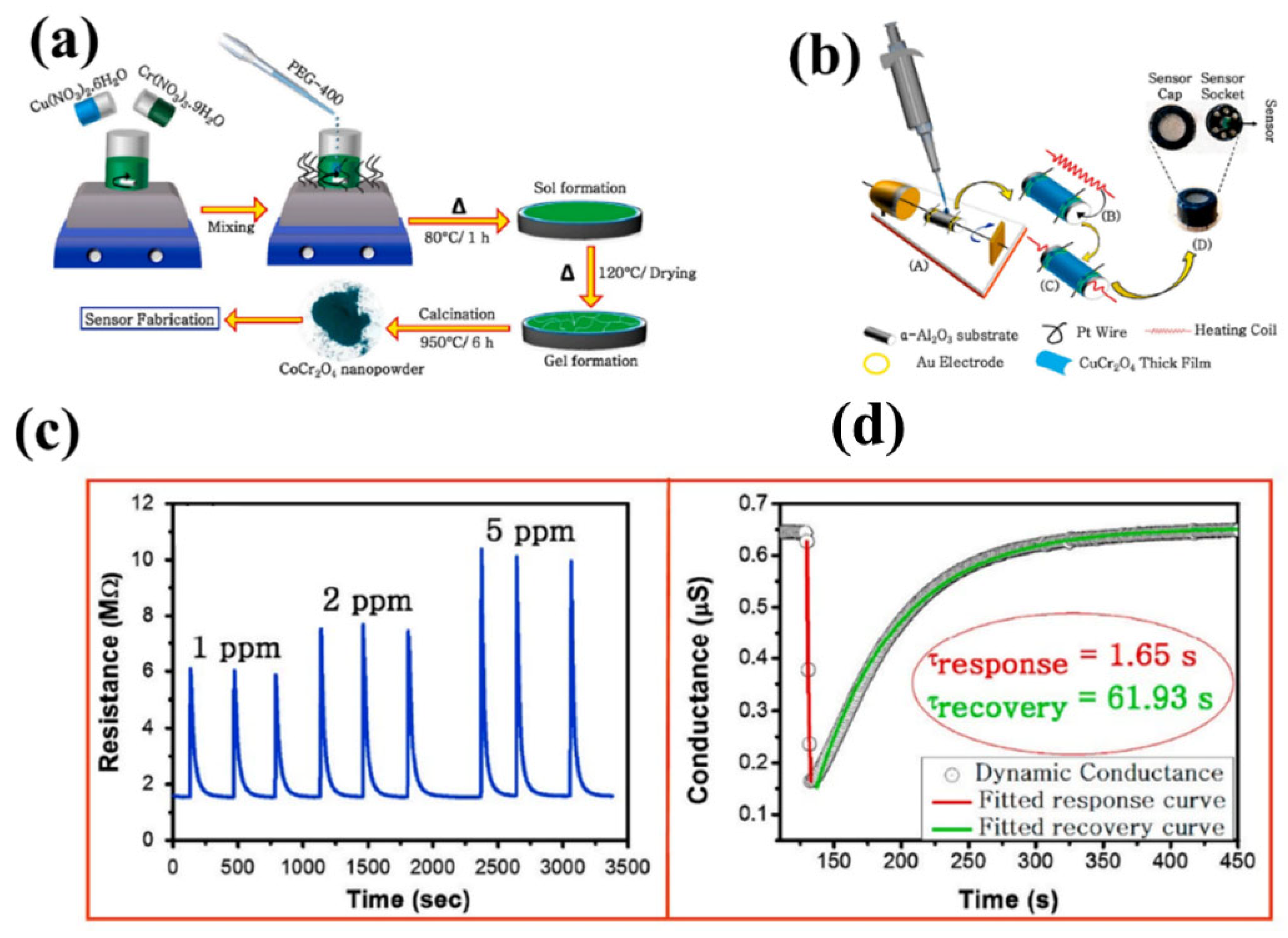


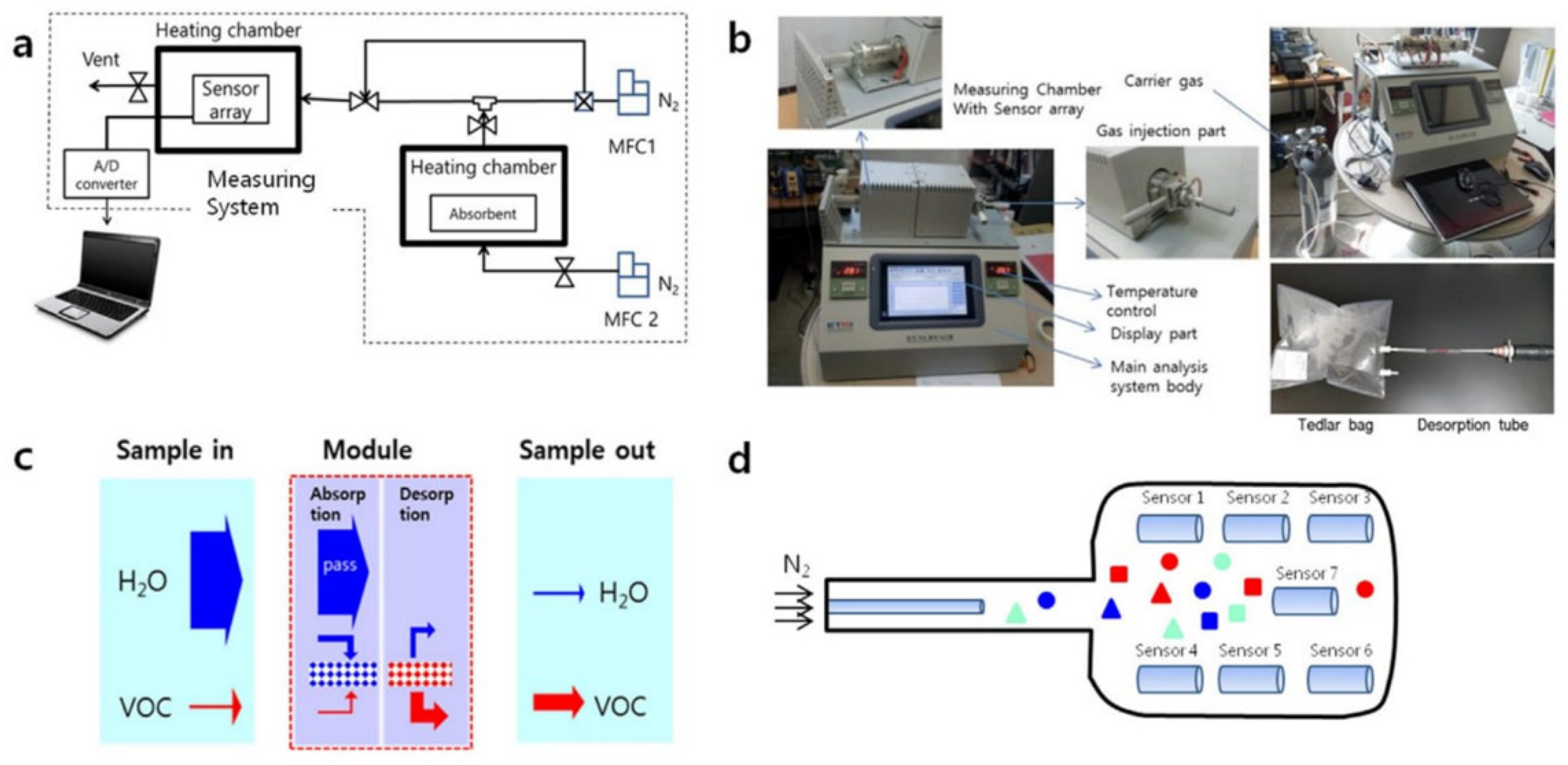
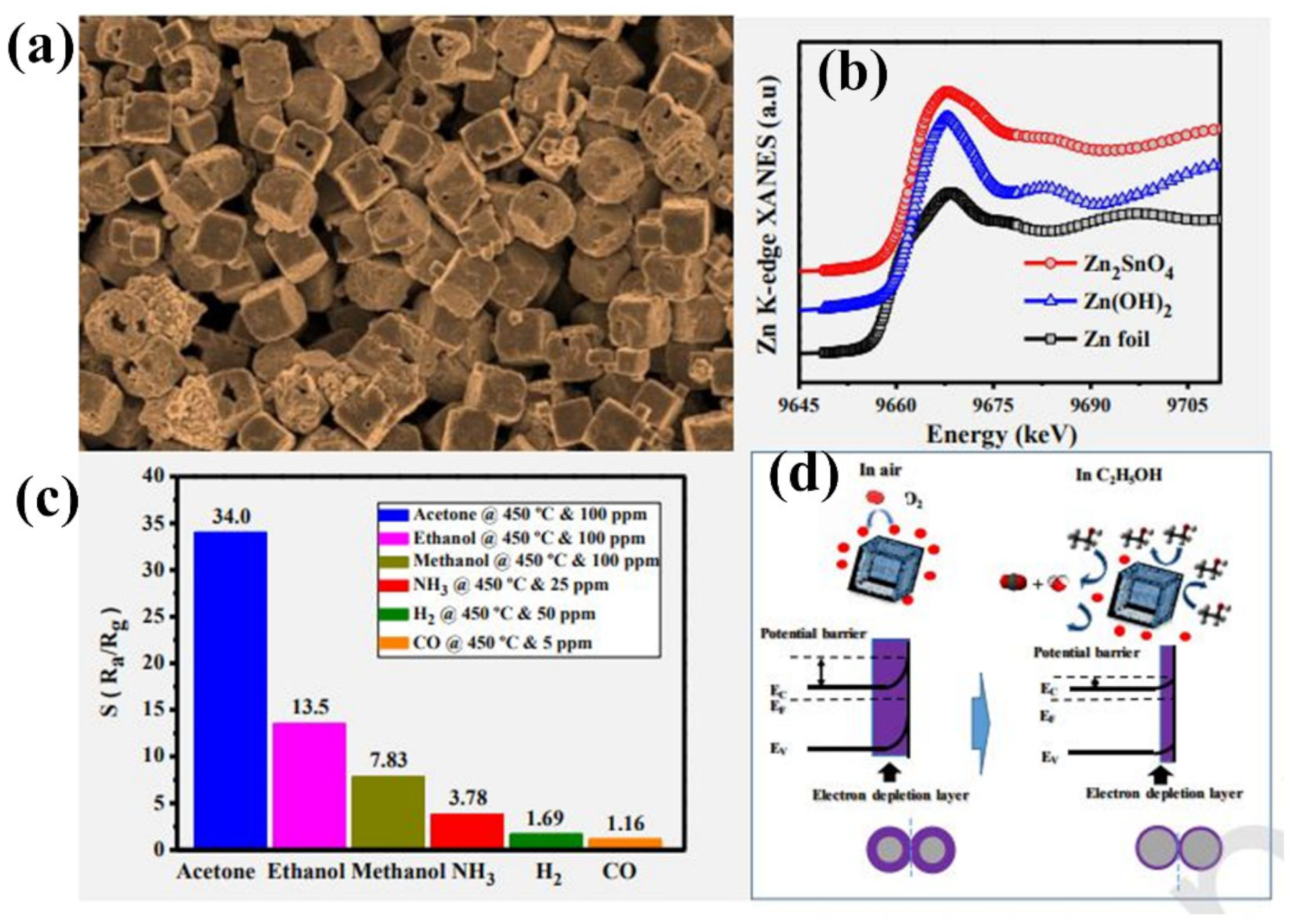
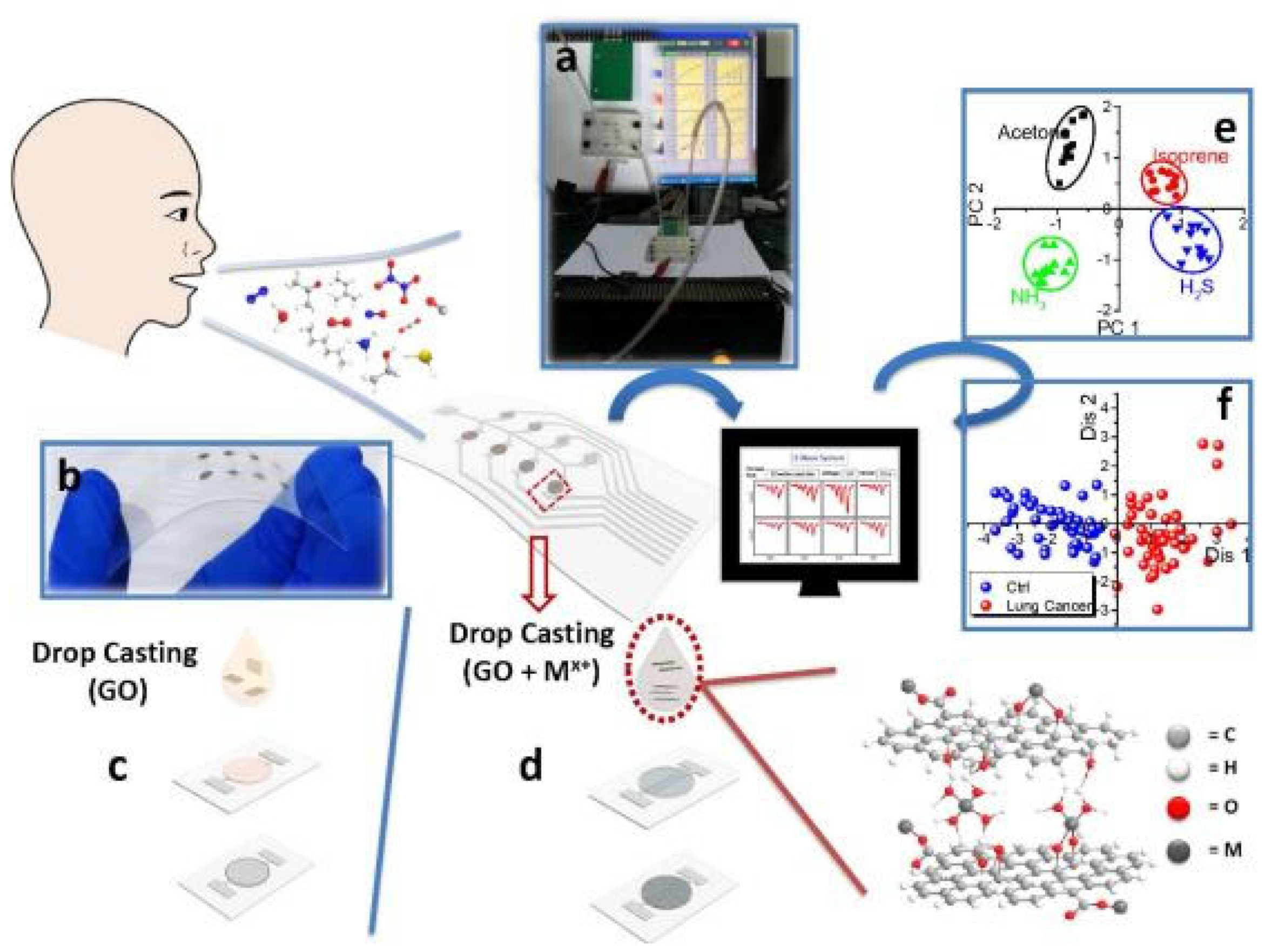
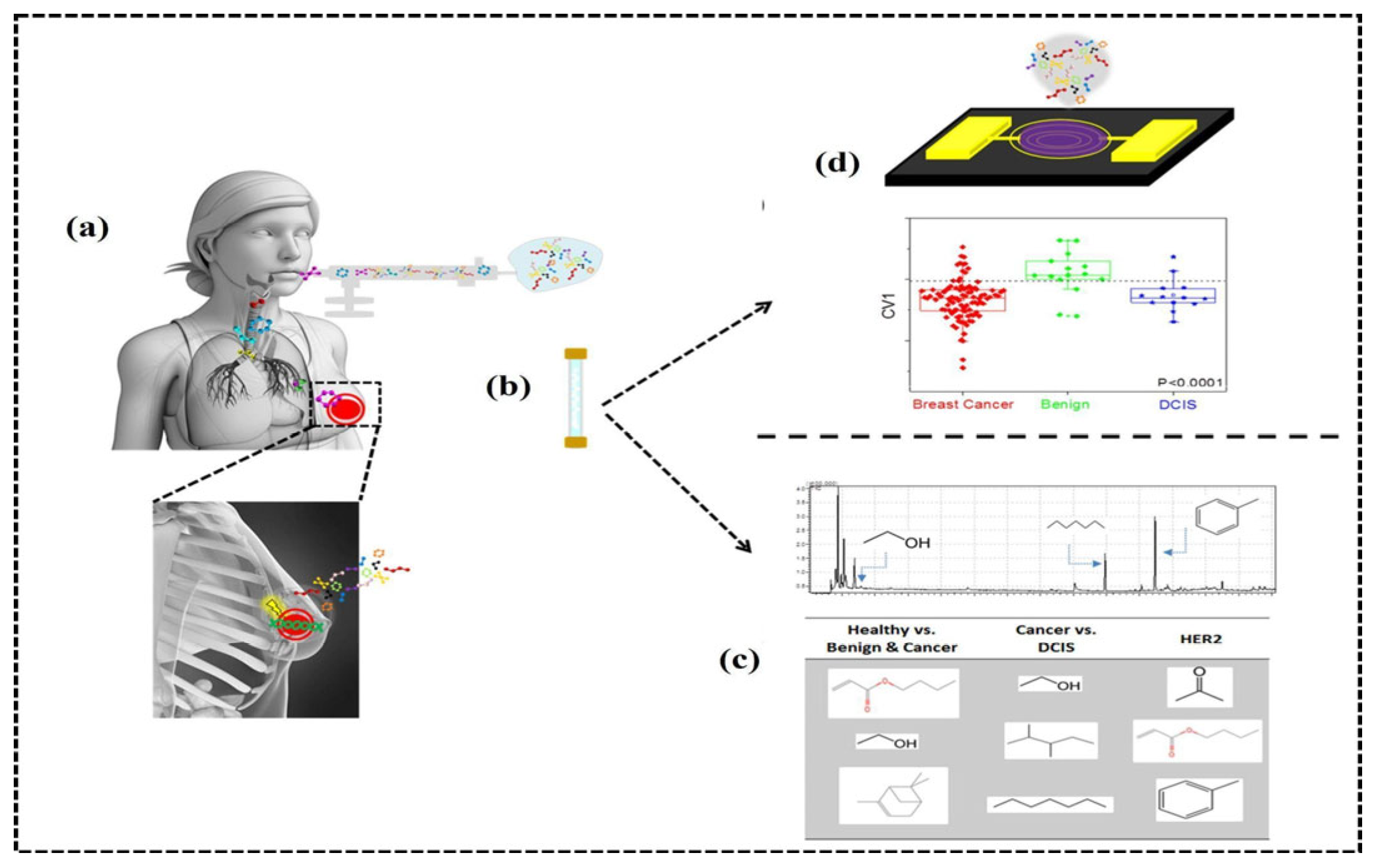
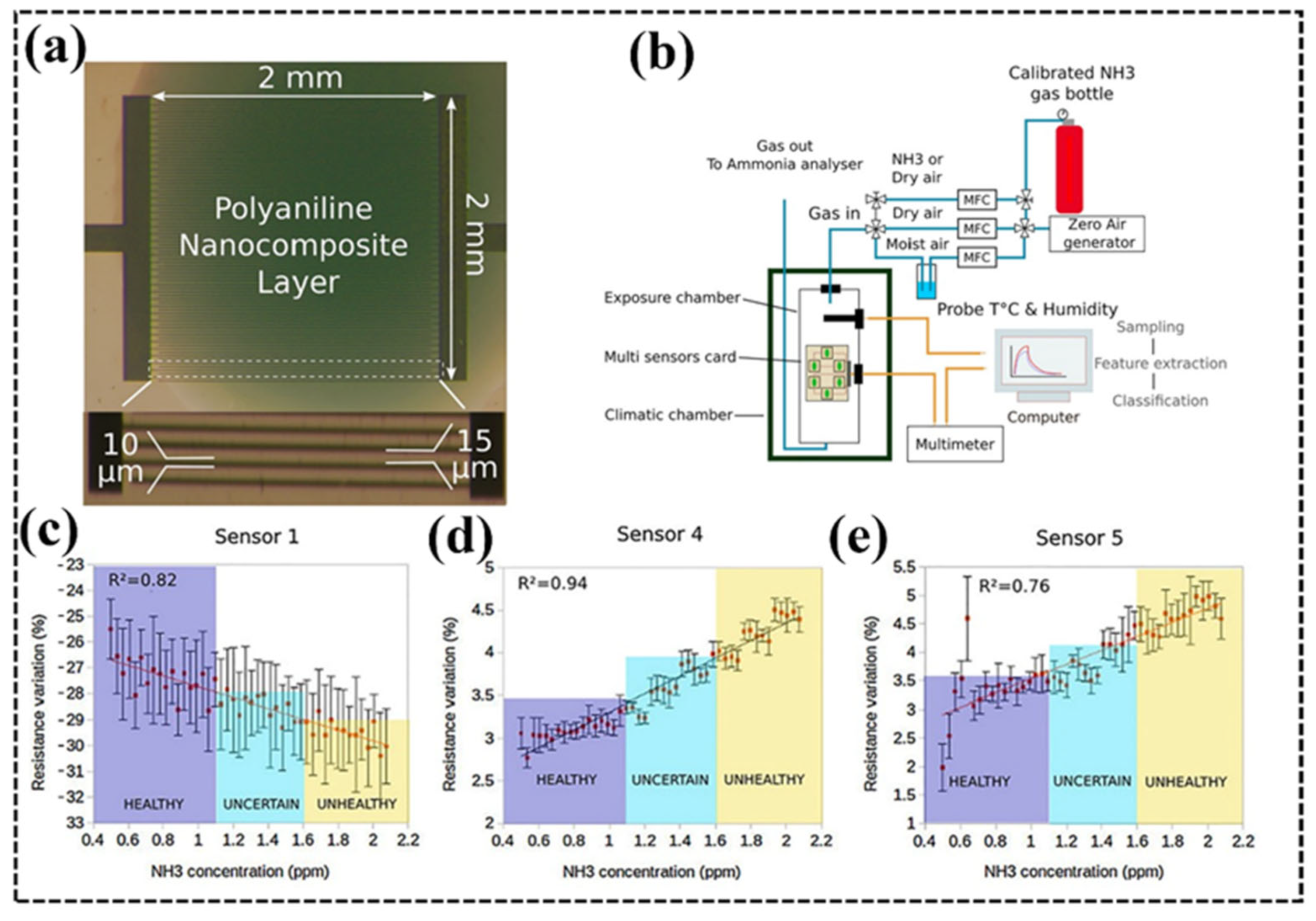
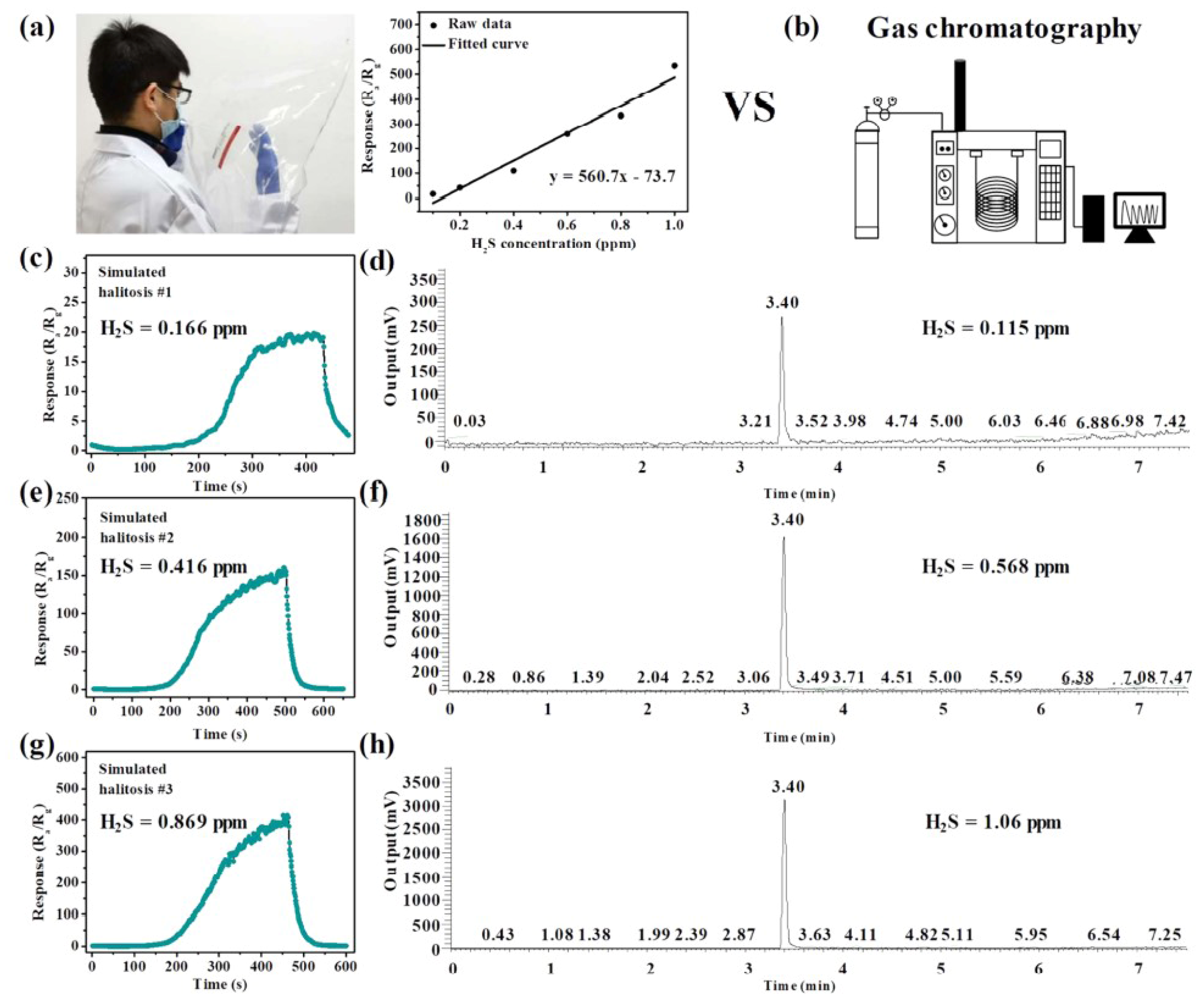

| No. | Disease | Disease-Related VOCs | Sample Sources | Ref. |
|---|---|---|---|---|
| 1 | Diabetes | Acetone; methyl nitrate; ethanol; | Breath | Novak et al., Galassetti et al. [18,19] |
| 2 | Lung Cancer | Octane; pentane; decane; 2-methylpentane; heptane; 2,3,5-trimethylhexane; 2,4-dimethyl-1-heptane; 4-methyloctane; isoprene; benzene; 1-propanol; acetone; butyl acetate; 2-pentane; toluene; styrene; 2,3,3-trimethylpentane; 2,4-dimethyl-1-heptane; | Breath; blood; urine. | Hakim et al. [20] |
| 3 | Breast Cancer | 3,3-dimethylpentane; 5-(2-methylpropylnonane; 2-amino-5-isopropyl-8-methyl-1-azulenecarbonitrile; 2,3,4-trimethyldecane; | Breath | Zhang et al., Phillips et al. [21,22] |
| 4 | Halitosis | Hydrogen sulphide; methanethiol | Breath | Choi et al. [23] |
| 5 | Kidney diseases | Ammonia | Breath | Spanel et al., Obermeier et al. [24,25] |
| Detection Methods | Principle | Advantages | Disadvantages | Image | References | ||||
|---|---|---|---|---|---|---|---|---|---|
| Physical Methods 1. Physical Spectroscopic Techniques | |||||||||
| 1.1. Mass Spectroscopy | |||||||||
| GC-MS | Analytes were separated and detected using ionization method | High sensitivity; high selectivity | Bulky; expensive; time-consuming | 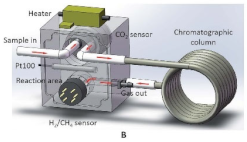 | F. Gao et al. Reprinted with permission from Ref. [41] Copyright 2009 RSC Publishing | ||||
| PTR-MS | Volatile compounds are ionized using gas phase H3O+ ions, which are subsequently separated using a mass spectrometer based on their m/z ratio | High sensitivity and the possibility of rapid quantification | Proton affinity greater than water molecule can only be detected | 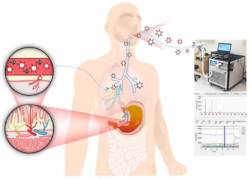 | Y. Jung et al. [42] | ||||
| SIFT-IMS | The mobility of each ion based on the applied electric field is related to the velocity of the ion | Eliminate need for sample preparation and pre-quantification, real-time measurements | Identification of VOCs are not always possible, no extensive compound library exists as with GC-MS | 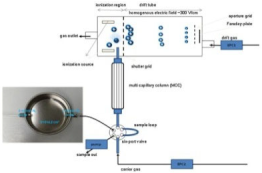 | V. Ruzsanyi et al. Reprinted with permission from Ref. [43] Copyright 2012 Elsevier | ||||
| 1.2. Laser Spectroscopy | |||||||||
| PAS | Quantity of light absorbed by a gas molecule or free atoms at a certain wavelength | Very sensitive, easy, efficient, and robust analytical method | Cost of the equipment. | 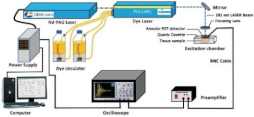 | J. Rodrigues et al. [44] | ||||
| MID-IR | Measurement of intensity variation in functional groups | Ultra trace sensitivity, high spectral resolution, non-destructive, label-free | Beam divergence | 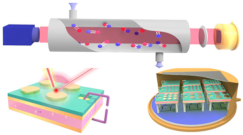 | X. Tan et al. [45] | ||||
| Chemical Methods 1. Nanomaterial-based techniques | |||||||||
| 1.1. Electrical | |||||||||
| Chemiresistors | Change in resistance or conductivity | Low cost; short response time, long-lasting | Relatively low sensitivity; high energy consumption | 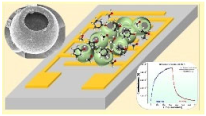 | S. Acharyya et al. Reprinted with permission from Ref. [46] Copyright 2021 American Chemical Society | ||||
| FET | Change in electrical behavior | Ultra-sensitive; adsorptive capacity; miniaturized; stability | Difficulties in fabrication; repeatability; high cost | 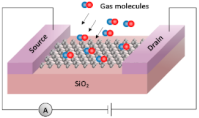 | A. Kukherjee et al. [47] | ||||
| 1.2. Electrochemical | |||||||||
| Amperometric | Measurement of electric current generated by chemical reactions in the electrochemical system. | Ultra-low power consumption; low cost; good selectivity; low detection limit; broad target gases; good for miniaturization | High maintenance if liquid electrolytes are used; interference may happen for some gases; slow response time |  | S. Achmann et al. [48] | ||||
| 1.3. Optical | |||||||||
| Evanescent | Change in absorption intensity | High sensitive, easy fabrication, low cost | Selectivity, repeatability |  | A. Prasanth et al. Reprinted with permission from Ref. [49] Copyright 2022 Elsevier | ||||
| SPR | Shift in resonant frequency | High sensitive, selective | Cost of the materials used for fabrication, polarizers, cost of the spectrometers | 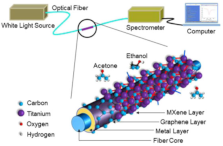 | V.R. Sudheer et al. [50] | ||||
| LMR | Shift in resonant frequency | Easy fabrication, free from polarizers | Cost of the spectrometers |  | A. Prasanth et al. Reprinted with permission from Ref. [51] Copyright 2021 Elsevier | ||||
| 1.4. Acoustic | |||||||||
| SAW | Wave velocity and frequency travels on the surface drift as a change in the external environment | High sensitivity, fast response, room temperature operation, low cost | Restricted with low frequency, not suitable for liquid samples |  | J. Devkota et al. [52] | ||||
| BAW | Wave velocity and frequency travels on the bulk drift as a change in the external environment | High sensitivity, robustness | Selectivity, costly | 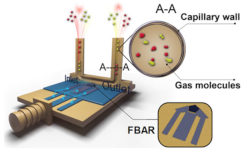 | J. Hu et al. [53] | ||||
| 1.5. Colorimetric | Based on the chemical reaction between the analytes, color change is observed | Cost-effective and simple | Irreversible and one-time use |  | A. Azzouz et al. Reprinted with permission from Ref. [54] Copyright 2019 Elsevier | ||||
| Materials | Concentration (ppm) | Response Ra/Rg | Selectivity (ppm) | T/°C | RH/% | Ref. |
|---|---|---|---|---|---|---|
| Co-doped ZnO nanofibers | 5 | 5 | 4 | 360 | 25 | Liu et al. [76] |
| Pd@ZnO | 50 | 30 | 1.9 | 340 | 25 | Xiao et al. [77] |
| Au/ZnO | 5 | 15 | 1.7 | 270 | NA | Wang et al. [78] |
| NiO-decorated ZnO | 10 | 3.6 | 1.9 | 300 | 30 | Liu et al. [79] |
| ZnO/ZnFe2O4 | 5 | 9.4 | 2.4 | 250 | NA | Ma et al. [80] |
| NiO/ZnO | 1 | 1.3 | 2 | 275 | 30 | Liu et al. [81] |
| ZnO nanosheets | 5 | 6.7 | 2.5 | 300 | 40 | Li et al. [82] |
| ZnO/ZnFe2O4 | 1 | 3.2 | 1.9 | 290 | NA | Wang et al. [83] |
| ZnO/ZnFe2O4 microspheres | 50 | 10 | 1.7 | 140 | NA | Song et al. [84] |
| ZnO supercrystals | 20 | 25.4 | 4.3 | 340 | NA | Gong et al. [85] |
| La/ZnO nanoplates | 50 | 25 | 1.8 | 330 | 24 | Li et al. [86] |
| SnO2 nanowires | 20 | 6 | 1.8 | 290 | 25 | Qin et al. [87] |
| Pt@WO3 | 1 | 62 | 31 | 350 | 90 | Kim et al. [88] |
| No. | Method/NM | VOC Biomarkers | Reference |
|---|---|---|---|
| 1 | Calorimetric/AuNR-MTPP | decane; hexanal; undecane; benzene; heptanal; and 1,2,4-trimethylbenzene | Huo et al. [97] |
| 2 | Chemiresistive/WO3 Nanofiber and composites | Hydrogen sulfide and toluene | Kim et al. [98] |
| 3 | Chemiresistive/ZnO and graphene | Acetone | Liu et al. [99] |
| 4 | Chemiresistive/functionalized β-cyclodextrin wrapped with rGO | Acetone; benzene; methanol; ethanol; formaldehyde; toluene; xylene; proponal; isopropanol | Nag et al. [100] |
| 5 | Chemiresistive/sulfonated poly nanocomposites based on hybrid nanocarbons | Methanol; ethanol; propanol; acetone; butanone; benzene; toluene; water | Nag et al. [101] |
| 6 | Chemiresistive/sensor array | Styrene; a-phellandrene; dodecane; 4-methyl | Agmon et al. [102] |
| 7 | Chemiresistive/WO3·0.33H2O, hexagonal-WO3, and their reduced graphene oxide composites | Acetone; benzene; methanol; toluene; m-xylene | Perfecto et al. [103] |
| 8 | UV light irradiation/WO3 nanowire doped with Pt, Au, Ni, Fe | Exhaled breath | Saidi et al. [104] |
| 9 | Chemiresistive method/carbon nanorods, PLA/CNR, PVA/CNR | Acetone; diethyl ether; carbon disulfide; acetonitrile; benzaldehyde; benzyl alcohol; trimethyl benzene; ethyl benzene; benzene; toluene; xylene; cyclohexane; hexene-1; 2-methyl-1-propanol; isopropanol; methanol; ethanol; water; formaldehyde | Tripathi et al. [105] |
| 10 | Chemiresistor/NP thin film | Acetone and hexane + acetone mixture | Zhao et al. [106] |
| 11 | Chemiresistive/porphyrin and its derivatives | p-xylene; styrene; isoprene and hexanal | Zhao et al. [107] |
| 12 | Optical LMR/poly[methyl(3,3,3- trifluoropropyl) siloxane] (PMTFPS) | ethane; benzene; heptane; toluene; octane; pentane; styrene and decane. | Silva et al. [108] |
| 13 | Optical LMR/Silver NP | Inhale and exhale Analysis | Rivero et al. [109] |
| 14 | Optical LMR/organometallic [Au2Ag2(C6F5)4(NH3)2]n | Methanol; ethanol and isopropanol | Elosua et al. [110] |
| 15 | Optical LMR/[Au2Ag2(C6F5)4(C6H5C CC6H5)2]n | Methanol; ethanol and isopropanol | Elosua et al. [111] |
| No. | Detection Technique | Functional Group | VOC Biomarkers | Ref. |
|---|---|---|---|---|
| 1 | GC-MS | Alkane | Pentane; H2O2; pentanol; hexanol | Phillips et al. [114] |
| 2 | GC-MS | Alkane | 3-methylhexane; decane; caryophyllene; naphthalene; and trichloroethylene | Mangler et al. [120] |
| 3 | GC-MS | n-Alkane | Ethane; pentane | Phillips et al. [121] |
| 4 | GC-MS | n-Methyl Alkane | 2-amino-5-isopropyl-8-methyl-1-azulenecarbonitrile; 3,3-dimethyl pentane; 5-(2-methylpropyl)nonane; 6-ethyl-3-octyl ester 2-trifluoromethyl benzoic acid; 2,3,4-trimethyl decane; | Schmidt et al. [122] |
| 5 | Nanowire-based chemiresistive sensor array | Aldehyde; alkane | 2,3-dihydro-1-phenyl-4(1H)-quinazolinone; isopropyl myristate; 2-propanol; 1-phenyl-ethanone; heptanal; | Sun et al. [123] |
| 6 | GC-MS | Alkane; aldehyde | Cyclohexane; dodecane; pentadecane; heptanal; 2-propanol; etc., | Silva et al. [124] |
| 7 | GC-MS | Alkene | 1-hexadecanol; 5-(z)-dodecenoic acid | Tanaka et al. [125] |
| 8 | GC-MS | Alkane | 2,5,6-trimethyl octane; 1,4-dimethoxy-2,3 butanediol; cyclohexane | Cai et al. [126] |
| 9 | GC-MS | Alcohol; alkane; aromatic | 2-hexyl-1-octanol; tridecane; benzene; 1,2,4,5-tetramethyl; 2,5-Cyclohexadiene-1,4-dione; 2,6-bis(1,1-dimethylethyl)-; cyclopropane; ethylidene | Phillips et al. [127] |
| 10 | GC-MS | Alkane | heptanal; dodecane; nonadecane; 3-methyl; octane; pentadecane; 6-methyl; propane; 2-methyl; tridecane; 5-methyl; 4-methyl; nonane; 2-methyl; | Phillips et al. [128] |
| 11 | GC-MS | Alkane; ketone; alcohol; | 2,3-dihydro-1-phenyl-4(1H)-quinazolinone; and isopropyl myristate; 2-propanol; 1-phenyl-ethanone; | Phillips et al. [129] |
| No. | Nanomaterial | VOC Biomarkers | Ref. |
|---|---|---|---|
| 1 | Si-doped α-MoO3 | NH3, H2S | Li et al. [131] |
| 2 | P3HT-based polymer | NH3 | Yu et al. [132] |
| 3 | Polyaniline nanocomposite | NH3 | Maout et al. [133] |
| 4 | RGO-SnO2 | NH3 | R.Ghosh et al. [134] |
| 5 | SnO2 | NH3 | A.Pathak et al. [135] |
| 6 | Gadolinium-doped tin oxide | NH3 | S. Maheswari et al. [136] |
| 7 | ITO-SWCNT | NH3 | F. Rigoni et al. [137] |
Publisher’s Note: MDPI stays neutral with regard to jurisdictional claims in published maps and institutional affiliations. |
© 2022 by the authors. Licensee MDPI, Basel, Switzerland. This article is an open access article distributed under the terms and conditions of the Creative Commons Attribution (CC BY) license (https://creativecommons.org/licenses/by/4.0/).
Share and Cite
Velumani, M.; Prasanth, A.; Narasimman, S.; Chandrasekhar, A.; Sampson, A.; Meher, S.R.; Rajalingam, S.; Rufus, E.; Alex, Z.C. Nanomaterial-Based Sensors for Exhaled Breath Analysis: A Review. Coatings 2022, 12, 1989. https://doi.org/10.3390/coatings12121989
Velumani M, Prasanth A, Narasimman S, Chandrasekhar A, Sampson A, Meher SR, Rajalingam S, Rufus E, Alex ZC. Nanomaterial-Based Sensors for Exhaled Breath Analysis: A Review. Coatings. 2022; 12(12):1989. https://doi.org/10.3390/coatings12121989
Chicago/Turabian StyleVelumani, Mohan, Asokan Prasanth, Subramaniyam Narasimman, Arunkumar Chandrasekhar, Abraham Sampson, Samir Ranjan Meher, Sivacoumar Rajalingam, Elizabeth Rufus, and Zachariah C. Alex. 2022. "Nanomaterial-Based Sensors for Exhaled Breath Analysis: A Review" Coatings 12, no. 12: 1989. https://doi.org/10.3390/coatings12121989
APA StyleVelumani, M., Prasanth, A., Narasimman, S., Chandrasekhar, A., Sampson, A., Meher, S. R., Rajalingam, S., Rufus, E., & Alex, Z. C. (2022). Nanomaterial-Based Sensors for Exhaled Breath Analysis: A Review. Coatings, 12(12), 1989. https://doi.org/10.3390/coatings12121989







